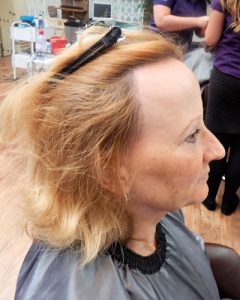The problem of hair loss due to alopecia has recently been highlighted by the rather ill-judged joke told at the Oscar ceremonies which was followed by Will Smith’s slap of the comedian who he felt told it against Smith’s wife, Jada Pinkett Smith, who suffers from it.
There are a number of different types of alopecia and this article explains what they are and the differences between them.
Alopecia areata
This is one of the most commonly reported types of hair loss, referring to bald patches or spots on the scalp. It is considered to be an auto-immune disorder and can be very unpredictable – sometimes the hair grows back – but it can recur without warning or fresh patches appear in different places. More information and examples of our approach to disguising it.
Alopecia totalis
 This is hair loss affecting the whole of the head, including eyelashes and eyebrows. It is a more advanced stage of alopecia areata, which progresses to totalis and universalis in around 1 – 2 per cent of cases.
This is hair loss affecting the whole of the head, including eyelashes and eyebrows. It is a more advanced stage of alopecia areata, which progresses to totalis and universalis in around 1 – 2 per cent of cases.
Alopecia universalis
This term relates to hair loss all over the body, meaning that the entire epidermis is free from hair. It is the most severe form of alopecia areata, and as such is quite rare, occurring only in around 1 in 100,000 people.
Androgenetic Alopecia
Known as Pattern Hair Loss there are male and female versions. The male pattern normally recedes from the front or the temples, whereas the female patttern is much more diffuse – thinnning over the head in general. More information on FPHL.
Frontal Fibrosing Alopecia
 Also known as Scarring Alopecia or Cicatricial Alopecia, it was only identified as recently as 1994. As with the related condition Lichen Planopilaris this type of hair loss is permanent due to the scar tissue generated by the inflammation that causes it. The hair follicles are destroyed and cannot grow back. It is characterised by a receding of the hairline at the front and sides of the scalp. More information on FFA.
Also known as Scarring Alopecia or Cicatricial Alopecia, it was only identified as recently as 1994. As with the related condition Lichen Planopilaris this type of hair loss is permanent due to the scar tissue generated by the inflammation that causes it. The hair follicles are destroyed and cannot grow back. It is characterised by a receding of the hairline at the front and sides of the scalp. More information on FFA.
Traction Alopecia
This is where hair falls out due to physical stress on the follicles – usually caused by overly-tight hair styles such as a severe ponytail, or by badly-fitted and/or too heavy extensions.
There are No Cures
While there are various creams and lotions which can help some of these conditions there are no cures, and most of the treatments have side-effects or are only suitable for men. Such treatments should only be used under medical advice and we do not offer them.
However we can disguise female hair loss very effectively with a variety of hair systems which we have developed and pioneered over the last four decades. These include the Intralace System and ultra-fine extensions called Medi Connections.
If you’d like to explore those otions then come and talk to us and we can asses the best approach for you. In the US we have studios at
9022 Burton Way
Beverly Hills
Tel: 310-288-0788
Inquiry form
and
Suite 607, 37 East 28th Street
New York City
Tel: 212-359-1641
Inquiry form
while if you are in the UK we have studios in London, Manchester, Edinburgh, Midlands (Solihull), Bristol, and Southampton. You can contact us there via our UK website.
